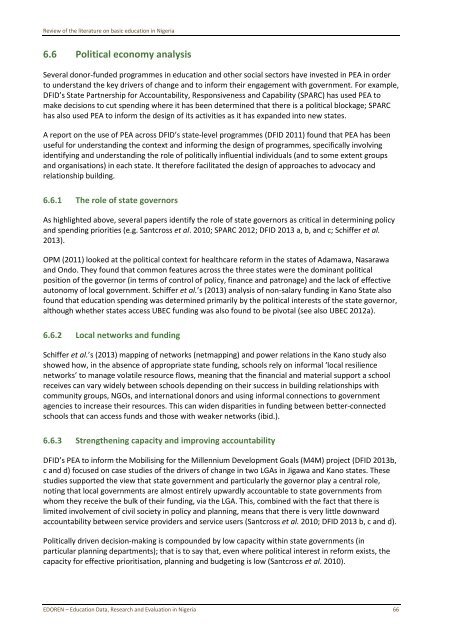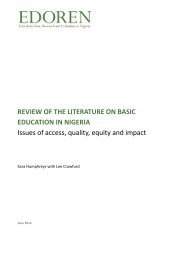Review <str<strong>on</strong>g>of</str<strong>on</strong>g> <str<strong>on</strong>g>the</str<strong>on</strong>g> <str<strong>on</strong>g>literature</str<strong>on</strong>g> <strong>on</strong> <strong>basic</strong> educati<strong>on</strong> <strong>in</strong> NigeriaWith<strong>in</strong> SMoEs, two <str<strong>on</strong>g>review</str<strong>on</strong>g>s <str<strong>on</strong>g>of</str<strong>on</strong>g> staff capacity found ‘poor job def<strong>in</strong>iti<strong>on</strong>s and <strong>in</strong>appropriate work methodsand procedures’ (Orbach 2004), as well as:… a lack <str<strong>on</strong>g>of</str<strong>on</strong>g> clear <str<strong>on</strong>g>of</str<strong>on</strong>g> roles and resp<strong>on</strong>sibilities and overlapp<strong>in</strong>g functi<strong>on</strong>s between departments; a highproporti<strong>on</strong> <str<strong>on</strong>g>of</str<strong>on</strong>g> ex-teachers with no management tra<strong>in</strong><strong>in</strong>g work<strong>in</strong>g <strong>in</strong> senior positi<strong>on</strong>s; no functi<strong>on</strong><strong>in</strong>gappraisal or performance management system and few pr<str<strong>on</strong>g>of</str<strong>on</strong>g>essi<strong>on</strong>al development opportunities for<strong>in</strong>dividuals (Johns<strong>on</strong> et al. 2007).The need to improve teacher recruitment, management, and tra<strong>in</strong><strong>in</strong>g has been highlighted <strong>in</strong> severalgovernment <str<strong>on</strong>g>review</str<strong>on</strong>g>s (e.g. FME 2005; FME 2011a). Thomas (2011) notes that <str<strong>on</strong>g>the</str<strong>on</strong>g>re is no process foreffective plann<strong>in</strong>g for <str<strong>on</strong>g>the</str<strong>on</strong>g> placement <str<strong>on</strong>g>of</str<strong>on</strong>g> teachers, which is centrally driven, lead<strong>in</strong>g to an unequaldistributi<strong>on</strong> between LGEAs. Appo<strong>in</strong>tments are <str<strong>on</strong>g>of</str<strong>on</strong>g>ten politicised or based <strong>on</strong> pers<strong>on</strong>al <strong>in</strong>fluence.Assessment processes need streng<str<strong>on</strong>g>the</str<strong>on</strong>g>n<strong>in</strong>g, as do promoti<strong>on</strong> procedures and opportunities forpr<str<strong>on</strong>g>of</str<strong>on</strong>g>essi<strong>on</strong>al development (see Secti<strong>on</strong> 10. 2).Cit<strong>in</strong>g a World Bank study <strong>on</strong> <str<strong>on</strong>g>the</str<strong>on</strong>g> staff<strong>in</strong>g situati<strong>on</strong> <strong>in</strong> 26 local governments <strong>in</strong> 13 states <strong>in</strong> Nigeria, <str<strong>on</strong>g>the</str<strong>on</strong>g>2004 ESA c<strong>on</strong>cluded that, ‘<str<strong>on</strong>g>the</str<strong>on</strong>g>re is hardly any discernible norm for recruitment and deployment <str<strong>on</strong>g>of</str<strong>on</strong>g> staffacross <str<strong>on</strong>g>the</str<strong>on</strong>g> states’ (FME 2005: 234).6.5.3 M<strong>on</strong>itor<strong>in</strong>g and evaluati<strong>on</strong>As already highlighted several times <strong>in</strong> this <str<strong>on</strong>g>review</str<strong>on</strong>g>, <str<strong>on</strong>g>the</str<strong>on</strong>g> lack <str<strong>on</strong>g>of</str<strong>on</strong>g> accurate data for <str<strong>on</strong>g>the</str<strong>on</strong>g> educati<strong>on</strong> sector –nati<strong>on</strong>ally and at state levels – is widely acknowledged <strong>in</strong> Nigeria and regarded as a major problem byboth federal and state governments <strong>in</strong> carry<strong>in</strong>g out M&E (FME 2005; FME 2011a; UBEC 2012a).Santcross et al. (2010) argue, however, that <str<strong>on</strong>g>the</str<strong>on</strong>g>re is a slowly grow<strong>in</strong>g demand for better data, as somestate governments realise <str<strong>on</strong>g>the</str<strong>on</strong>g>y need an evidence base for decisi<strong>on</strong>-mak<strong>in</strong>g and <strong>in</strong>formed plann<strong>in</strong>g.Abalu et al. (2013) make <str<strong>on</strong>g>the</str<strong>on</strong>g> case that <str<strong>on</strong>g>the</str<strong>on</strong>g>re is latent capability <strong>in</strong> M&E that is not utilised. They arguethat M&E could be politically successful if framed <strong>in</strong> terms <str<strong>on</strong>g>of</str<strong>on</strong>g> enhanc<strong>in</strong>g politicians’ credibility and as ameans <str<strong>on</strong>g>of</str<strong>on</strong>g> improv<strong>in</strong>g learn<strong>in</strong>g about policy ra<str<strong>on</strong>g>the</str<strong>on</strong>g>r than enforc<strong>in</strong>g accountability. Despite <str<strong>on</strong>g>the</str<strong>on</strong>g>se optimisticassessments about future possibilities, however, <str<strong>on</strong>g>the</str<strong>on</strong>g>y do note that at present <str<strong>on</strong>g>the</str<strong>on</strong>g>re is very littlem<strong>on</strong>itor<strong>in</strong>g <str<strong>on</strong>g>of</str<strong>on</strong>g> spend<strong>in</strong>g and outputs, or evaluati<strong>on</strong> <str<strong>on</strong>g>of</str<strong>on</strong>g> public policy.F<strong>in</strong>dlay (2013) <str<strong>on</strong>g>review</str<strong>on</strong>g>ed <str<strong>on</strong>g>the</str<strong>on</strong>g> ASC, which <strong>in</strong>forms <str<strong>on</strong>g>the</str<strong>on</strong>g> EMIS and provides <strong>in</strong>formati<strong>on</strong> <strong>on</strong> schoolenrolment. The ASC/EMIS was judged to be poorly implemented <strong>in</strong> many states. The EMIS wasdecentralised to states <strong>in</strong> 2007 with little support or additi<strong>on</strong>al fund<strong>in</strong>g from FGN. However, F<strong>in</strong>dlayreported some improvement <strong>in</strong> states supported through ESSPIN, although it is worth reiterat<strong>in</strong>g <str<strong>on</strong>g>the</str<strong>on</strong>g>po<strong>in</strong>t that any improvement at LGEA and state level <strong>in</strong> <str<strong>on</strong>g>the</str<strong>on</strong>g> EMIS <str<strong>on</strong>g>of</str<strong>on</strong>g>fices will be underm<strong>in</strong>ed if <strong>in</strong>dividualhead teachers do not produce reliable, school-level data; data <strong>on</strong> teacher and head teacher recordkeep<strong>in</strong>gsuggests that this is a c<strong>on</strong>cern (see Secti<strong>on</strong> 11.2).Informati<strong>on</strong> <strong>on</strong> <str<strong>on</strong>g>the</str<strong>on</strong>g> number <str<strong>on</strong>g>of</str<strong>on</strong>g> teachers and <str<strong>on</strong>g>the</str<strong>on</strong>g>ir qualificati<strong>on</strong>s is more accurate and is collected through<str<strong>on</strong>g>the</str<strong>on</strong>g> teacher payroll managed by <str<strong>on</strong>g>the</str<strong>on</strong>g> SUBEBs, although this will not <strong>in</strong>clude teachers who are hiredlocally, paid for by PTAs, for example, or who work <strong>in</strong> private schools.Mezger (2013) <str<strong>on</strong>g>review</str<strong>on</strong>g>ed <str<strong>on</strong>g>the</str<strong>on</strong>g> several household surveys that also estimate enrolment levels, not<strong>in</strong>g thatmany provide <strong>in</strong>c<strong>on</strong>sistent numbers.There is no regular data collecti<strong>on</strong> <strong>on</strong> learn<strong>in</strong>g achievement, but some ad hoc surveys (e.g. MLA, NAUBE,EGRA, etc.) do provide some <strong>in</strong>formati<strong>on</strong>. Results from <str<strong>on</strong>g>the</str<strong>on</strong>g>se surveys were summarised <strong>in</strong> Secti<strong>on</strong> 5.3.The poor state <str<strong>on</strong>g>of</str<strong>on</strong>g> expenditure data has been discussed above.EDOREN – Educati<strong>on</strong> Data, Research and Evaluati<strong>on</strong> <strong>in</strong> Nigeria 65
Review <str<strong>on</strong>g>of</str<strong>on</strong>g> <str<strong>on</strong>g>the</str<strong>on</strong>g> <str<strong>on</strong>g>literature</str<strong>on</strong>g> <strong>on</strong> <strong>basic</strong> educati<strong>on</strong> <strong>in</strong> Nigeria6.6 Political ec<strong>on</strong>omy analysisSeveral d<strong>on</strong>or-funded programmes <strong>in</strong> educati<strong>on</strong> and o<str<strong>on</strong>g>the</str<strong>on</strong>g>r social sectors have <strong>in</strong>vested <strong>in</strong> PEA <strong>in</strong> orderto understand <str<strong>on</strong>g>the</str<strong>on</strong>g> key drivers <str<strong>on</strong>g>of</str<strong>on</strong>g> change and to <strong>in</strong>form <str<strong>on</strong>g>the</str<strong>on</strong>g>ir engagement with government. For example,DFID’s State Partnership for Accountability, Resp<strong>on</strong>siveness and Capability (SPARC) has used PEA tomake decisi<strong>on</strong>s to cut spend<strong>in</strong>g where it has been determ<strong>in</strong>ed that <str<strong>on</strong>g>the</str<strong>on</strong>g>re is a political blockage; SPARChas also used PEA to <strong>in</strong>form <str<strong>on</strong>g>the</str<strong>on</strong>g> design <str<strong>on</strong>g>of</str<strong>on</strong>g> its activities as it has expanded <strong>in</strong>to new states.A report <strong>on</strong> <str<strong>on</strong>g>the</str<strong>on</strong>g> use <str<strong>on</strong>g>of</str<strong>on</strong>g> PEA across DFID’s state-level programmes (DFID 2011) found that PEA has beenuseful for understand<strong>in</strong>g <str<strong>on</strong>g>the</str<strong>on</strong>g> c<strong>on</strong>text and <strong>in</strong>form<strong>in</strong>g <str<strong>on</strong>g>the</str<strong>on</strong>g> design <str<strong>on</strong>g>of</str<strong>on</strong>g> programmes, specifically <strong>in</strong>volv<strong>in</strong>gidentify<strong>in</strong>g and understand<strong>in</strong>g <str<strong>on</strong>g>the</str<strong>on</strong>g> role <str<strong>on</strong>g>of</str<strong>on</strong>g> politically <strong>in</strong>fluential <strong>in</strong>dividuals (and to some extent groupsand organisati<strong>on</strong>s) <strong>in</strong> each state. It <str<strong>on</strong>g>the</str<strong>on</strong>g>refore facilitated <str<strong>on</strong>g>the</str<strong>on</strong>g> design <str<strong>on</strong>g>of</str<strong>on</strong>g> approaches to advocacy andrelati<strong>on</strong>ship build<strong>in</strong>g.6.6.1 The role <str<strong>on</strong>g>of</str<strong>on</strong>g> state governorsAs highlighted above, several papers identify <str<strong>on</strong>g>the</str<strong>on</strong>g> role <str<strong>on</strong>g>of</str<strong>on</strong>g> state governors as critical <strong>in</strong> determ<strong>in</strong><strong>in</strong>g policyand spend<strong>in</strong>g priorities (e.g. Santcross et al. 2010; SPARC 2012; DFID 2013 a, b, and c; Schiffer et al.2013).OPM (2011) looked at <str<strong>on</strong>g>the</str<strong>on</strong>g> political c<strong>on</strong>text for healthcare reform <strong>in</strong> <str<strong>on</strong>g>the</str<strong>on</strong>g> states <str<strong>on</strong>g>of</str<strong>on</strong>g> Adamawa, Nasarawaand Ondo. They found that comm<strong>on</strong> features across <str<strong>on</strong>g>the</str<strong>on</strong>g> three states were <str<strong>on</strong>g>the</str<strong>on</strong>g> dom<strong>in</strong>ant politicalpositi<strong>on</strong> <str<strong>on</strong>g>of</str<strong>on</strong>g> <str<strong>on</strong>g>the</str<strong>on</strong>g> governor (<strong>in</strong> terms <str<strong>on</strong>g>of</str<strong>on</strong>g> c<strong>on</strong>trol <str<strong>on</strong>g>of</str<strong>on</strong>g> policy, f<strong>in</strong>ance and patr<strong>on</strong>age) and <str<strong>on</strong>g>the</str<strong>on</strong>g> lack <str<strong>on</strong>g>of</str<strong>on</strong>g> effectiveaut<strong>on</strong>omy <str<strong>on</strong>g>of</str<strong>on</strong>g> local government. Schiffer et al.’s (2013) analysis <str<strong>on</strong>g>of</str<strong>on</strong>g> n<strong>on</strong>-salary fund<strong>in</strong>g <strong>in</strong> Kano State als<str<strong>on</strong>g>of</str<strong>on</strong>g>ound that educati<strong>on</strong> spend<strong>in</strong>g was determ<strong>in</strong>ed primarily by <str<strong>on</strong>g>the</str<strong>on</strong>g> political <strong>in</strong>terests <str<strong>on</strong>g>of</str<strong>on</strong>g> <str<strong>on</strong>g>the</str<strong>on</strong>g> state governor,although whe<str<strong>on</strong>g>the</str<strong>on</strong>g>r states access UBEC fund<strong>in</strong>g was also found to be pivotal (see also UBEC 2012a).6.6.2 Local networks and fund<strong>in</strong>gSchiffer et al.’s (2013) mapp<strong>in</strong>g <str<strong>on</strong>g>of</str<strong>on</strong>g> networks (netmapp<strong>in</strong>g) and power relati<strong>on</strong>s <strong>in</strong> <str<strong>on</strong>g>the</str<strong>on</strong>g> Kano study alsoshowed how, <strong>in</strong> <str<strong>on</strong>g>the</str<strong>on</strong>g> absence <str<strong>on</strong>g>of</str<strong>on</strong>g> appropriate state fund<strong>in</strong>g, schools rely <strong>on</strong> <strong>in</strong>formal ‘local resiliencenetworks’ to manage volatile resource flows, mean<strong>in</strong>g that <str<strong>on</strong>g>the</str<strong>on</strong>g> f<strong>in</strong>ancial and material support a schoolreceives can vary widely between schools depend<strong>in</strong>g <strong>on</strong> <str<strong>on</strong>g>the</str<strong>on</strong>g>ir success <strong>in</strong> build<strong>in</strong>g relati<strong>on</strong>ships withcommunity groups, NGOs, and <strong>in</strong>ternati<strong>on</strong>al d<strong>on</strong>ors and us<strong>in</strong>g <strong>in</strong>formal c<strong>on</strong>necti<strong>on</strong>s to governmentagencies to <strong>in</strong>crease <str<strong>on</strong>g>the</str<strong>on</strong>g>ir resources. This can widen disparities <strong>in</strong> fund<strong>in</strong>g between better-c<strong>on</strong>nectedschools that can access funds and those with weaker networks (ibid.).6.6.3 Streng<str<strong>on</strong>g>the</str<strong>on</strong>g>n<strong>in</strong>g capacity and improv<strong>in</strong>g accountabilityDFID’s PEA to <strong>in</strong>form <str<strong>on</strong>g>the</str<strong>on</strong>g> Mobilis<strong>in</strong>g for <str<strong>on</strong>g>the</str<strong>on</strong>g> Millennium Development Goals (M4M) project (DFID 2013b,c and d) focused <strong>on</strong> case studies <str<strong>on</strong>g>of</str<strong>on</strong>g> <str<strong>on</strong>g>the</str<strong>on</strong>g> drivers <str<strong>on</strong>g>of</str<strong>on</strong>g> change <strong>in</strong> two LGAs <strong>in</strong> Jigawa and Kano states. Thesestudies supported <str<strong>on</strong>g>the</str<strong>on</strong>g> view that state government and particularly <str<strong>on</strong>g>the</str<strong>on</strong>g> governor play a central role,not<strong>in</strong>g that local governments are almost entirely upwardly accountable to state governments fromwhom <str<strong>on</strong>g>the</str<strong>on</strong>g>y receive <str<strong>on</strong>g>the</str<strong>on</strong>g> bulk <str<strong>on</strong>g>of</str<strong>on</strong>g> <str<strong>on</strong>g>the</str<strong>on</strong>g>ir fund<strong>in</strong>g, via <str<strong>on</strong>g>the</str<strong>on</strong>g> LGA. This, comb<strong>in</strong>ed with <str<strong>on</strong>g>the</str<strong>on</strong>g> fact that <str<strong>on</strong>g>the</str<strong>on</strong>g>re islimited <strong>in</strong>volvement <str<strong>on</strong>g>of</str<strong>on</strong>g> civil society <strong>in</strong> policy and plann<strong>in</strong>g, means that <str<strong>on</strong>g>the</str<strong>on</strong>g>re is very little downwardaccountability between service providers and service users (Santcross et al. 2010; DFID 2013 b, c and d).Politically driven decisi<strong>on</strong>-mak<strong>in</strong>g is compounded by low capacity with<strong>in</strong> state governments (<strong>in</strong>particular plann<strong>in</strong>g departments); that is to say that, even where political <strong>in</strong>terest <strong>in</strong> reform exists, <str<strong>on</strong>g>the</str<strong>on</strong>g>capacity for effective prioritisati<strong>on</strong>, plann<strong>in</strong>g and budget<strong>in</strong>g is low (Santcross et al. 2010).EDOREN – Educati<strong>on</strong> Data, Research and Evaluati<strong>on</strong> <strong>in</strong> Nigeria 66
- Page 1 and 2:
REVIEW OF THE LITERATURE ON BASICED
- Page 3 and 4:
Review of
- Page 5 and 6:
Review of
- Page 7 and 8:
Review of
- Page 9 and 10:
Review of
- Page 11 and 12:
Review of
- Page 13 and 14:
Review of
- Page 15 and 16:
Review of
- Page 17 and 18:
Review of
- Page 19 and 20:
Review of
- Page 21 and 22:
Review of
- Page 23 and 24:
Review of
- Page 25 and 26:
Review of
- Page 27 and 28:
Review of
- Page 29 and 30:
Review of
- Page 31 and 32:
Review of
- Page 33 and 34:
Review of
- Page 35 and 36:
Review of
- Page 37 and 38:
Review of
- Page 39 and 40:
Review of
- Page 41 and 42: Review of
- Page 43 and 44: Review of
- Page 45 and 46: Review of
- Page 47 and 48: Review of
- Page 49 and 50: Review of
- Page 51 and 52: Review of
- Page 53 and 54: Review of
- Page 55 and 56: Review of
- Page 57 and 58: Review of
- Page 59 and 60: Review of
- Page 61 and 62: Review of
- Page 63 and 64: Review of
- Page 65 and 66: Review of
- Page 67 and 68: Review of
- Page 69 and 70: Review of
- Page 71 and 72: Review of
- Page 73 and 74: Review of
- Page 75 and 76: Review of
- Page 77 and 78: Review of
- Page 79 and 80: Review of
- Page 81 and 82: Review of
- Page 83 and 84: Review of
- Page 85 and 86: Review of
- Page 87 and 88: Review of
- Page 89 and 90: Review of
- Page 91: Review of
- Page 95 and 96: Review of
- Page 97 and 98: Review of
- Page 99 and 100: Review of
- Page 101 and 102: Review of
- Page 103 and 104: Review of
- Page 105 and 106: Review of
- Page 107 and 108: Review of
- Page 109 and 110: Review of
- Page 111 and 112: Review of
- Page 113 and 114: Review of
- Page 115 and 116: Review of
- Page 117 and 118: Review of
- Page 119 and 120: Review of
- Page 121 and 122: Review of
- Page 123 and 124: Review of
- Page 125 and 126: Review of
- Page 127 and 128: Review of
- Page 129 and 130: Review of
- Page 131 and 132: Review of
- Page 133 and 134: Review of
- Page 135 and 136: Review of
- Page 137 and 138: Review of
- Page 139 and 140: Review of
- Page 141 and 142: Review of
- Page 143 and 144:
Review of
- Page 145 and 146:
Review of
- Page 147 and 148:
Review of
- Page 149 and 150:
Review of
- Page 151 and 152:
Review of
- Page 153 and 154:
Review of
- Page 155 and 156:
Review of
- Page 157 and 158:
Review of
- Page 159 and 160:
Review of
- Page 161 and 162:
Review of
- Page 163 and 164:
Review of
- Page 165 and 166:
Review of
- Page 167 and 168:
Review of
- Page 169 and 170:
Review of
- Page 171 and 172:
Review of
- Page 173 and 174:
Review of
- Page 175 and 176:
Review of
- Page 177 and 178:
Review of
- Page 179 and 180:
Review of
- Page 181 and 182:
Review of
- Page 183 and 184:
Review of
- Page 185 and 186:
Review of
- Page 187 and 188:
Review of
- Page 189 and 190:
Review of
- Page 191 and 192:
Review of
- Page 193 and 194:
Review of
- Page 195 and 196:
Review of
- Page 197 and 198:
Review of
- Page 199 and 200:
Review of
- Page 201 and 202:
Review of
- Page 203 and 204:
Review of
- Page 205 and 206:
Review of
- Page 207 and 208:
Review of
- Page 209 and 210:
Review of



